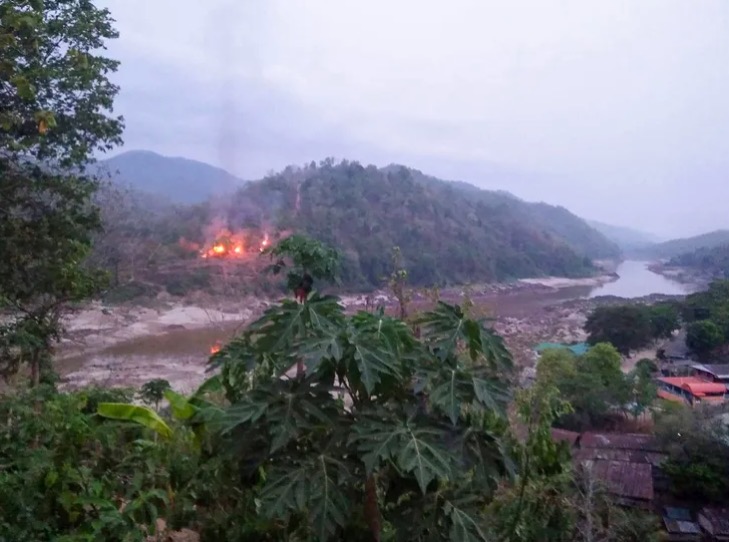On February 1, 2021, one day prior to the inauguration of the newly elected government, the Myanma military initiated a coup d’état, forming the State Administration Council (SAC). Since the oppressive regime has taken over, a revolution led by pro-democracy advocates has ignited within the country.
This is not the first time that pro-democracy movements in Myanmar have arisen. National scale uprisings took place in 1962, 1988 and 2007, all to no avail. In 2015, however, the citizens’ government took partial control from the military in a democratic election. The National League for Democracy (NLD), a political party led by pro-democracy advocates, had a second successful election last February. As a result, the military seized power from the democratic government.
While known internationally as the 2021 Myanmar Protests, the current uprising is locally referred to as the ‘Spring Revolution.’ While the use of the term ‘revolution’ is often contested, especially with regard to uprisings in Myanmar, many advocates make the case that the Spring Revolution is, indeed, a revolution.
“What is happening in Myanmar is a textbook revolution. What is different [from previous uprisings] is that not just students and monks are uprising, labor and farm workers, doctors and engineers are. This is organically society based. You see young people on the streets, it’s quite inspiring, but what [is behind the scenes] is resistance from the private sector like green grocers, mom and pop shops and department stores. The private sector decided that the military crossed the line,” Co-Founder of Forces of Renewal Southeast Asia group Dr. Maung Zarni said.
This is the fourth nationwide uprising since the military took control in 1962. Yet, two key components of the Spring Revolution differ from the previous protests. The first is a new source of motivation.
“This generation, who has suffered through the dark years, and suddenly were finding interesting opportunities, were so distressed by this because they’ve tasted both. They’ve tasted, in the last ten years, what the possibilities are, the potential that was being realized. They also know what it was like to be in a ditch,” Vice President of Early College Policies and Programs at Bard College at Simon’s Rock Dr. U Ba Win said.
The protestors involved in the uprisings of 1988 and 2007 could not fully understand how addictive even an ounce of freedom could be. That liberty has, barely, been provided to this generation.
The second difference between the Spring Revolution and Myanmar’s previous movements is the internet. Since the so-called ‘Saffron Revolution’ of 2007, internet access in Myanmar has increased exponentially, from less than one percent to now 30%.
“Internet in Myanmar is not like internet in America. It is simply Facebook, and everyone is hooked on Facebook like opium,” Zarni said.
Quickly, the Myanma military realized that the internet could be used as a tool against them. Almost as soon as citizen journalists in Myanmar realized they could record military crackdowns on Facebook Live, the Myanma military banned the site. In return, solidarity movements of youth groups across Asia, such as the Milk Tea Alliance, taught youth in Myanmar to use VPNs to bypass the ban and to use Twitter rather than Facebook, resulting in the use of #WhatsHappeningInMyanmar on the platform.
Documentation to foreign bystanders is not the only important use for the internet. Communication and coordination is vital among leaders of this revolution, especially between insurgent groups such as ethnic armed organizations (EAOs), which are often in conflict with each other. The National Unity Government of Myanmar (NUG), an alternative government, which is made up of members of EAOs, activists and politicians in exile, was announced mid-April. Because a vast majority of members are in exile, the government communicates online.
Without stable modes of communication, disputes which set the movement back could be exacerbated. This ability to communicate through the internet has created a battleground in and of itself, one which prioritizes skill over force.
[NOTE: As this is being edited, the Myanma military has shut down satellite television, in addition to internet services. This is an attempt to shut out any foreign influence, or any opinions which oppose the military]
Despite these differences from previous uprisings, many of the effects of conflict on society have stayed the same. The Spring Revolution has created one new, frightening parallel to the 1988 uprising. Education has been halted. After the 1988 uprising, and later protests in 1996 and 1998, higher education was banned in Myanmar. Currently, internet shutdowns and violent conflict in the streets of Myanmar have made it nearly impossible to receive a primary, secondary or higher education.
“Going to schools is dangerous. It is like a warzone in the streets. It is hard to go from one place to another. The coup regime is trying to make it look normal. So soon, they will be reopening the schools and encouraging people to go to schools, yet there are problems with safety for students. In the past [few weeks] or so, people are now thinking about what should be done about education. [Additionally], online school is not possible because of internet shutdowns,” a source who requested to remain anonymous for their safety told The Sentry.
Peaceful protests in the streets are often met by lethal force from the Myanma military, resulting in more than 760 casualties as of May 4, according to the Assistance Association for Political Prisoners. That number cannot be independently verified, and is likely to be higher.
“In pressing down the protests in Bago recently, they used heavy weapons to kill more than 80 people in one night. We’re not talking about automatic handheld weapons anymore, we’re talking grenade launchers,” Ba Win said.
Protesters in Myanmar have experience regarding fighting against violent military crackdown. The protesters of generations prior refined protest tactics over several decades. These tactics, which have been missing until the past few weeks, have started to occur in Yangon, Myanmar’s largest city. Recently, protesters have started placing handmade bombs at government buildings and roads. Flash-mobs in open city centers lasting ten minutes began to appear last week.
These protest tactics are resulting in increased security throughout the city. Barricades have been erected throughout the city, blocking off important streets in areas which many protesters used. Frequent checkpoints can be found throughout Yangon as well.
“I would be going somewhere and suddenly I see a barricade, a checkpoint, and I would have to turn around because if I go through the checkpoint and explain myself, even without protesting, I could be asked to get out of the car and taken away and told to bring x amount of money to leave the next day,” the unnamed source said.
Street Protests are only one front of the violence against the Myanmar military. Organized violence against the military exists through the previously mentioned militia-style ethnic armed organizations.
There are over 20 armed insurgent groups in Myanmar, termed ethnic armed organizations. These rebel groups control over one-third of the land in Myanmar, largely along the country’s borders. The largest of these groups have more than 10,000 soldiers, and since the coup, have fought against the military.
While some of these groups have decided to work with the military, the most prominent groups, such as the Kachin, Karen, Arakan and Chinland groups have fought against the military. In past weeks, the Kachin army overtook multiple military bases and shot down a helicopter. The Chinland Defence Force claimed responsibility for the deaths of multiple police recently.
In late March, the predecessor to the NUG, the Committee Representing Pyidaungsu Hluttaw (CRPH), with endorsements from many EAOs and peaceful anticoup protesters, declared the 2008 constitution void. Many experts argue that the very existence of this declaration gives the Myanmar military no more legitimacy than the EAOs, but rather a ‘coup regime.’
“What we have is a scenario where the military has morphed into a terrorist group with an air force and a navy at its disposal. Because of that, the entire society has turned against them. The military deployed a classic divide and rule across ethnic and religious lines. The people realized that this is not a national armed force. A national armed force does not deploy snipers and kill children in front of their own parents, burn things down, loot, rob, or threaten to rape women. It is no different than ISIS or Boko Haram or Al Qaeda. The military has failed to run the state. The economy is not functioning, and the state is failing,” Zarni said.
[NOTE: As this is being edited, the NUG has announced it is forming a defense force against the SAC. This military will likely lead to an extremely violent civil war in Myanmar, one which many citizens believe is necessary.]
With two ineffective governments, dozens of militaries and constant violence in the streets, Myanmar is in the first revolution in the digital age, and it is showing us what revolutions will look like for decades to come. The internet has completely reshaped how revolutions are fought, how foreign powers understand the revolution and how armed resistance groups unite.







































